Etude
 }
}
Disruptions in banking are pushing banks to take more explicit strategy decisions. Many banks have recognized that they need a truly differentiated strategy as the industry’s economics have come under pressure from new technology and entrants with disruptive business models. Large technology firms such as Internet giant Alibaba in China and messaging giant Kakao in South Korea have also been moving into markets such as payments, raising customers’ expectations for better digital tools and simple, convenient service. Ever-stricter capital and liquidity requirements by regulators have reduced banks’ own balance sheet leverage. Low interest rates and low economic growth intensify the pressure.
As a result, more banks are making difficult strategic choices. Some have exited countries where they had invested heavily for many years; Citibank and HSBC, for example, have decided to leave consumer banking in Brazil. Others are reinventing their core identity, with Citigroup CEO Michael Corbat characterizing Citi as “a technology company with a banking license.”
Difficult as strategic choices may be, banks are finding it even more challenging to adapt their operating models quickly to a new strategy—indeed, it’s often the biggest obstacle to implementing a distinctive strategy. Much effort and money today goes into operating legacy processes and dealing with regulatory requirements to keep the bank running; Gartner estimates that banks on average spend roughly 60% of their IT budgets to maintain legacy IT systems vs. just 24% to grow the business and 16% to transform it. The global financial crisis, moreover, prompted a greater aversion to risk, and many banks’ legacy talent pools, processes and IT systems remain ill-suited to major change.
Thomas Olsen, a partner with Bain's Financial Services practice, outlines four things banks are doing to develop new operating models that can adapt for the future.
A core strategy choice that affects operating models
One key choice with implications for the operating model involves where to compete on the value chain spectrum. Banks can focus on “manufacturing” (creating products) at one end of the spectrum or on “distribution” (managing channels and customer relationships) at the other end. Most banks will choose a hybrid of the two, based on their relative strength in individual products, customer segments and internal capabilities (see Figure 1). Advances in technology make it easier to unbundle the value chain, and we believe the distinction between manufacturing and distribution will accelerate over time.
Financial institutions pursuing a manufacturing-intensive strategy include Goldman Sachs, State Street and Black Rock. They aim to build world-class solutions for specific product needs and client segments, including other financial institutions. Succeeding through this model hinges on attaining large-scale product leadership and technological expertise. Some banks are relying on external vendors to perform parts of the process, such as FIS, IBM, SAP and Misys for core banking and product systems; Broadridge and First Data for servicing and business-process outsourcing; and IHS Markit, Bloomberg and Thompson Reuters for data and analytics.
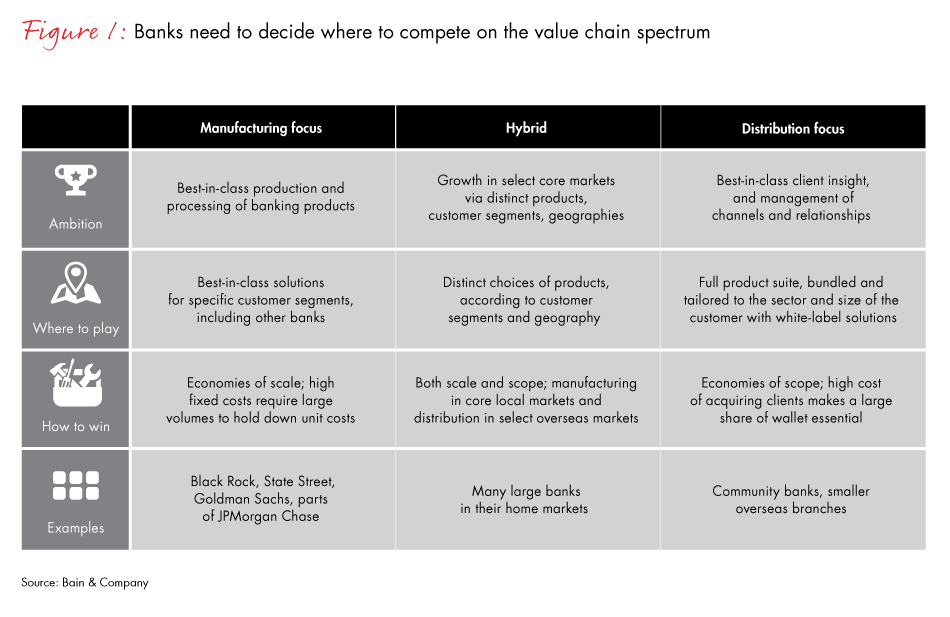
The distribution model is attracting many regional and community banks, credit unions and parts of large banks that want to focus on areas where they have a competitive advantage. Distribution-focused banks tend to offer a full product suite, tailored to particular industries or customer profiles with a combination of non-bank, white-label solutions and partnerships with other banks. That means they outsource many products and processes such as credit cards, asset management or insurance, as well as utility-type activities such as mortgage processing. Success with the distribution model hinges on customer analytics, strong customer relationships, channels that are simple and easy to use, and economies of scope achieved by gaining a large share of the customer’s wallet.
Most large banks will choose to compete along the broad middle of the spectrum. They look for growth in select markets where they have a distinct set of products and customer segments, and they combine elements of scale and scope by, say, manufacturing in their local market and distributing overseas. Lloyds Bank, for example, manufactures trade-finance products in the UK, while it partners with Standard Chartered in Asia.
Redesigning the operating model for the new age
Just as banks have been relearning the art of strategy to build competitive advantage, they also must develop operating models uniquely suited to their strategy, rather than models based on generic industry benchmarks. Banks will have to rethink the role, structure and processes of critical functions such as IT, risk and compliance. For instance, more banks are moving to open architecture, which means they no longer have complete end-to-end control internally of their IT systems or data. This trend has been spurred by the migration to cloud solutions, and will further accelerate with the spread of distributed ledger technology, smart contracts and open application programming interface (API) systems that integrate activities across the financial system. Banks will have to redesign processes to understand and monitor activities handled by external providers, not by the bank itself.
Manufacturers must deepen their product innovation and ability to scale up. At times, they will rely on other financial institutions to market their products, via partnerships or white labeling. Banks taking the distribution route have the reverse challenge of unbundling activities, then finding and managing other parties to provide them.
To be clear, what we mean by operating model is the blueprint for how resources are organized and operated to get work done. It takes shape through choices in five areas (see Figure 2):
- structure—the matrix of products, geographies and segments that will work best for manufacturing or distribution;
- accountabilities—aligning roles and responsibilities to excel in key capabilities;
- governance—speeding up the critical decisions in capital allocation, IT, capex, product design and vendor choice;
- ways of working—calibrating a culture that fosters collaboration across functions and with vendors, which has not been a strength of traditional banks; and
- capabilities—combining people, processes and technology to reinforce the elements of the strategy that will enable a bank to stand apart from the pack. Most institutions can truly master only three or four capabilities. Manufacturing tends to lean heavily on back-end capabilities like cost discipline, product design and straight-through processing. By contrast, distribution relies more on customer advocacy, strong relationship managers and marketing.
So how can bank executives design and build an adaptive operating model that will sustain growth and profitability? Leading banks are making inroads in five areas that allow them to build models that suit their strategies-in-the-making and can flex as new priorities emerge (see Figure 3).
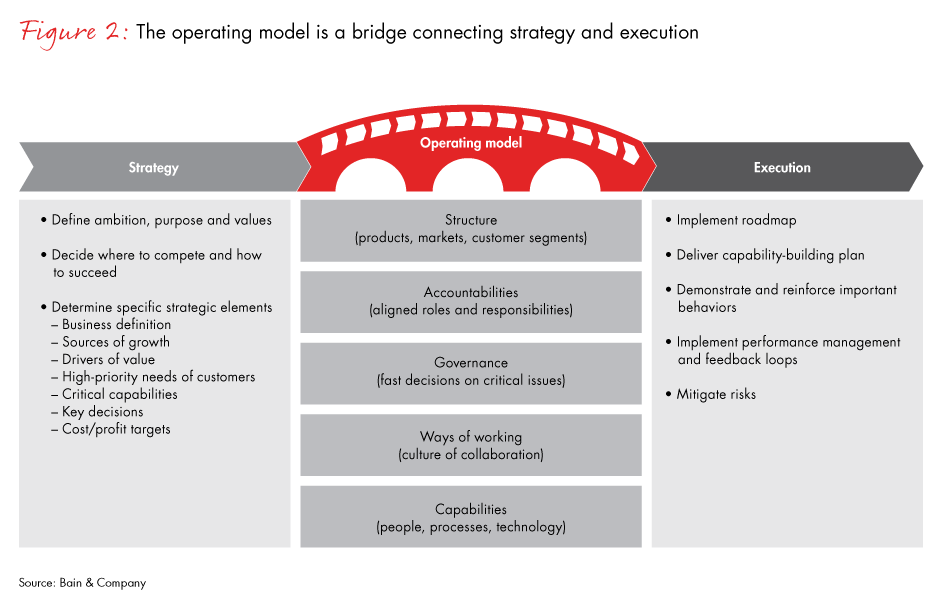
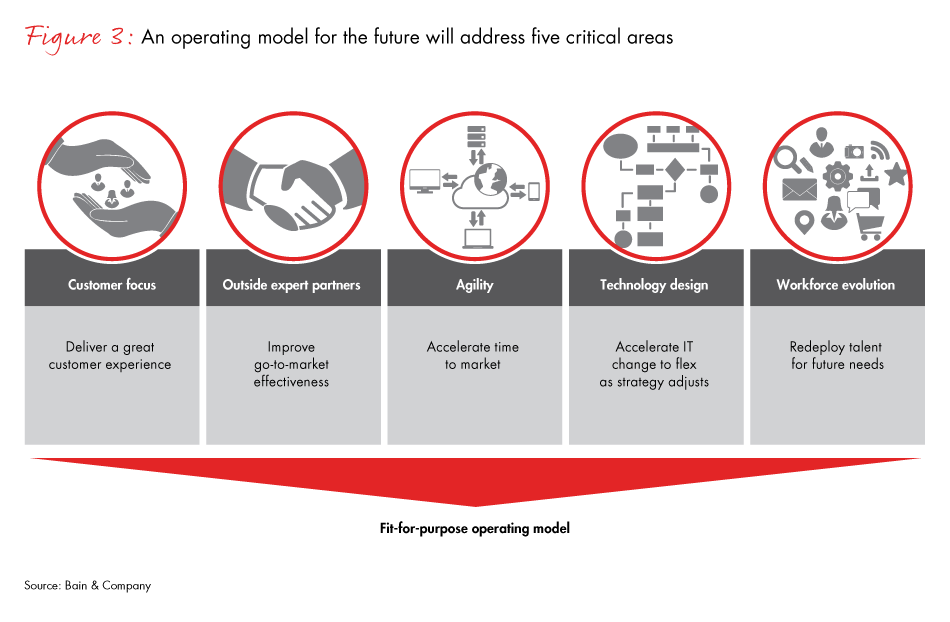
Put customer priorities at the center of the design. Viewing products and services from the customer’s perspective is essential for delivering an end-to-end experience that will reliably delight customers.
Consider Citibank Asia, which has a strong customer loyalty position in a number of its markets, but set even more ambitious loyalty goals to counter the pressure from locally based competitors that were gaining ground. Citi changed its operating model in several ways. It modified the organizational superstructure to elevate the role of customer segment heads, giving them authority over products and channels for those segments. And it put in place a team charged with ensuring an excellent experience for each customer segment.
Reach outside the bank for expert partners. At any point along the spectrum from manufacturing to distribution, banks are plugging into an ecosystem of third-party vendors, open APIs, fintechs and other banks to deliver products more effectively.
Manufacturers have been establishing partnerships, in part to efficiently build scale. Bank of China and Deutsche Bank set up a host-to-host platform for domestic and international payments. Some banks have established partnerships with fintech companies, such as JPMorgan Chase partnering with OnDeck to approve and fund small business loans in as little as a day. And multibank portals are proliferating to serve corporate clients. Seven of Europe’s largest banks are building a shared cross-border trade-finance platform for small and medium-size companies, using distributed ledger technology. The point is to simplify trade-finance processes by connecting all of the parties online and via mobile devices.
Distributors, by contrast, turn to vendors to raise the level of their operations so they can compete with manufacturers in certain products. Some fintech companies have grown large enough to offer nearly off-the-shelf “bank in a box” capabilities, especially for small banks. That was the logic behind the recent merger announcement of Misys with D+H. Another fintech company, PrimeRevenue, offers supply chain finance through a cloud-enabled platform to banks such as Barclays and Nordea. The platform is designed to simplify processes, increase liquidity, and provide analysis of credit and working capital for corporate customers. Through Nordea, the platform also allows suppliers of automaker Volvo to selectively sell their Volvo receivables to Nordea.
More partnering is inevitable, given the unbundling of banking. But it raises challenges for banks that are accustomed to working through their internal departments and now have less control over the people and IT involved in providing services. When an insurance company’s staff works in a bank’s branches and uses tablets that collect customer data, untangling who owns what data and how to ensure data security typically pushes each organization into new territory; regulation often varies from one country to another, further complicating partnerships. Executives will also need to resolve questions about which entity owns the customer relationship and which is responsible for compliance.
Get Agile fast. Most banks have started to use Agile methods in their software development. Few, though, have taken it to scale beyond a few individual projects. New competitors move faster than banks in making and implementing decisions, and as technology such as open APIs makes it easier for customers to switch providers, banks risk increasing customer churn. A practical way to speed up the metabolism of the organization is adopting Agile to improve the overall customer experience.
Banks that have taken a year to develop products through traditional Waterfall methods now can do so in a matter of weeks through Agile. While Agile does not work well for every activity (such as closing the books each quarter), it can accelerate time to market for new products and services, and adapt quickly to changes in the market environment (see Figure 4).
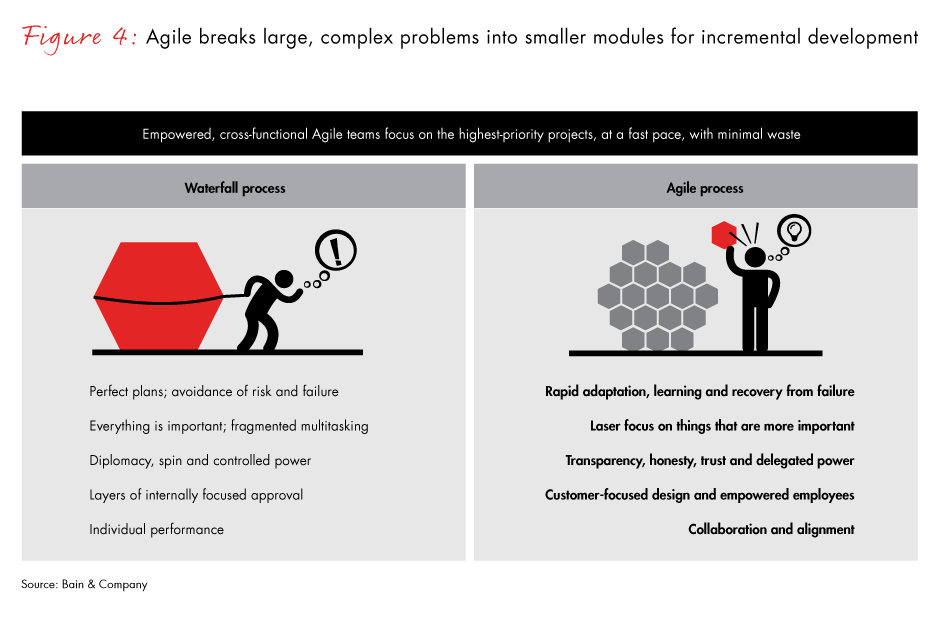
Among banks that have started to take Agile to a larger scale, a few have focused their Agile teams on redesigning and managing entire customer episodes, rather than just products. Episodes consist of a task that a customer must complete or a need he or she wants to fulfill, with a clear start and end. They range from a single interaction (paying another person online) to an intricate series of interactions (buying a home, which includes securing a mortgage). Focusing on episodes forces the team to take the customer’s perspective and to involve any function that influences the quality of the experience.
A leading financial services company turned to Agile to support its goal of organizing around customer experiences rather than products. In doing so, it sharpened the focus on raising speed to market and ensuring consistently high customer loyalty scores for sales and service delivery, especially in predominantly digital channels. The company uses Agile, cross-functional teams of 8 to 10 people, aligned to specific customer episodes. Each team brings together the requisite capabilities in business, design, processes and technology. The company now is taking its experience-led Agile approach to scale across the enterprise, through waves of applied learning sessions, and is well on its way to improving productivity by three to four times. To fill gaps in capabilities, the company retooled existing resources through training and added employees with design and data skills.
Modernize your legacy IT. Strategy doesn’t stand still, and neither should the technology that supports it. Moving away from legacy IT is such a complex task that many banks have delayed it. In effect, they are kicking the can down the road. The proliferation of fintechs and the encroachment of large tech firms into banking make it abundantly clear that digital technologies have provided compelling and distinctive customer experiences, often at a lower cost than the previous generation of experiences. Banks that accelerate their replacement of legacy IT stand to gain a competitive edge that will be hard to erode.
A few general principles will keep IT relevant: Cap legacy IT spending and reduce it wherever possible to free up funding for new IT, such as the cloud. Enable all channels with digital technology. Move to straight-through, paperless processes. Build a single, smart view of the customer. And use modular systems architecture that can flex.
Strong, flexible IT also requires traditional banks to make organizational changes. Banks should determine where to maintain standardized, centralized IT solutions—say, in payments infrastructure—and where execution should be handled by the business units, as in the development of mobile applications.
The C-suite will need to step up its knowledge and commitment as well. Senior executives may not understand all the implications of disruptive technology or appreciate how the entire company, not just the IT group, must work differently. But they cannot allow risk aversion to paralyze the organization. While accepting the role of legacy IT systems for the foreseeable future, senior executives should methodically pursue modernization and retirement of outdated systems based on risk/value trade-offs.
Find and redeploy new types of talent. As automation pervades more activities and, at the same time, banks sharpen their focus on delivering a better customer experience, their workforce must evolve. Thousands of roles are becoming obsolete, including tellers, back-office processors—even routine call-center agents, as chatbots take on simple inquiries.
We have seen conventional technologies help banks to double labor productivity every few years, through digitalizing processes and applying more sophisticated industrial methods like capacity planning and Lean Six Sigma. Opimas, a research firm, estimates that by 2025, the rollout of artificial intelligence (AI) technology by financial institutions will reduce employment in the capital markets by 230,000 people, with the largest impact in the asset management industry, where machines will replace around 90,000 people.
Taiger, for instance, combines machine learning with natural-language processing to automatically identify, extract, cleanse and validate pieces of information from many types of documents. The banking applications include client onboarding, due diligence and fighting money laundering. After a large European bank shifted to Taiger’s technology for client onboarding, its cost fell 85% and turnaround time shrank from several weeks to seven minutes, with no loss in quality. As AI spreads throughout the industry, bank professionals who previously performed those activities may need to retool their expertise.
The greatest talent challenge for banks may be attracting technical specialists. Banks have run into a dearth of talent in advanced analytics, new technologies such as blockchain and customer experience design. The shortage is compounded by competition from culturally more attractive fintechs and companies in other industries. Banks will have to get creative in attracting and nurturing top talent, through such tactics as mobility programs for top performers in key roles, and by adapting their cultures.
Questions for executives
As bank executives consider how to redesign their operating model to suit an evolving strategy, they can start by asking a few pointed questions (see Figure 5):
- How should we adapt our organizational structure? Should we design fit-for-purpose operating models for different business areas?
- Do we know what capability gaps exist and how to close them?
- Does our IT respond to clearly defined business unit requirements?
- What workforce changes need to occur and how will we attract the talent we need?
- How do we finance the change? Is our corporate center set up to actively prioritize resources?
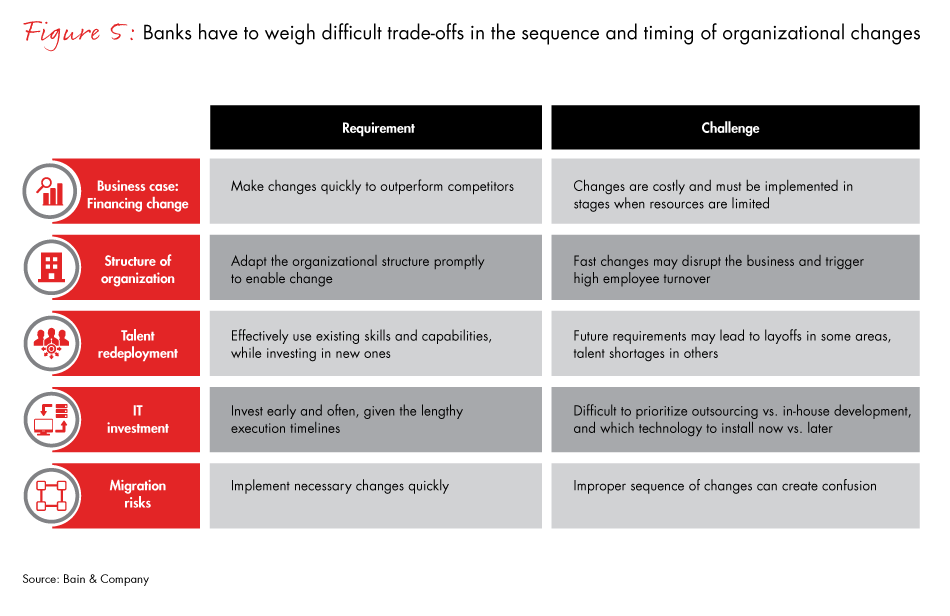
Perhaps the most important question: How much time do we have? Adjusting operating models can involve getting agreement with regulators, workers councils and other stakeholders, which can easily drag out the process even when banks feel some urgency. At the same time, banks are facing competitors that started from scratch and have the passion of insurgents. The disruption caused by technology and evolving customer expectations will not let up. Banks that take too much time to realign or overhaul their operating models risk being left high and dry.
Thomas Olsen, Mark Judah, Joe Fielding, Niels Peder Nielsen and Stephen Phillips are partners in Bain & Company’s Financial Services practice. They are based, respectively, in Singapore, Melbourne, New York, Copenhagen and London.

Agile Insights
Agile Innovation techniques are spreading beyond software development to a wide range of industries and functions. Bain's Agile Insights explore how companies can adopt scrum thinking.
